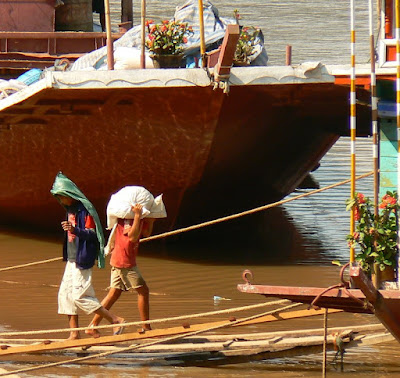
It seems like the koke and the saat, (in English mortar and pestle), are in use preparing every meal. If nothing else, they are used to crush and pulverize the spices that go in every food. The order in which ingredients are added to the koke is determined by what the ingredient is being used for. Hot peppers and dried spices that need to be crushed into tiny pieces often go in first, liquids like fish sauce are often added last to clean the other things off the side of the koke. Sometimes like in making Tom Mac Kune, that salad made with slivers of green papaya, the green papaya is added at the very end and slightly dented. The denting causes the juices to be soaked up by the papaya more than just mixing. Salt and Bang Nua added early and used to help puree the hot peppers.
It seems like you never see people dicing or grating.
The hollow thunk, thunk, of the saat hitting the coke is a dinner gong telling me food might just be appearing within the next little while to an hour.
The koke itself is non porous even though made of clay, it doesn’t soak up the juices, the rough textured sides help in grinding up things like fresh toasted peanuts or fibrous ginger or kha that looks like ginger.
The inside slopes steeply to the bottom causing loose things to fall and gather at the bottom. You don’t need to aim too well to hit the food with the saat every time.
It’s said a broken koke brings bad luck to the household. I’ll bet, as in someone has to go buy another one and food isn’t good until then, I’d call that bad luck. Prudence suggests a careful examination of any koke before buying to check for minute cracks. Of course if cracks do develop it never hurts to go buy a new one and retire the old one to be used as a flower pot or something. Never hurts to cover all possibilities.

Above are the ingredients for jeao mac len, and my rice basket. Mine is the one with the athletic tape sewn over the edge. I’ve used the same basket to take my rice to work for about ten years now. It was made by one of my sister in law’s boyfriends.
The rice basket on the right is a gift from a woman who was jailed for selling ya ma. I think she was doing quite a long time, perhaps five or ten years, in any case she is out now within the last couple months, hooray. The basket has the finest and smallest weaving I’ve ever seen, she had lots of time on her hands. Notice the dark colour? I think the bamboo was darkened in smoke, it somehow hardens the bamboo. Notice the string has a fancy woven handle as do the edges of the basket. The weaving is so small I think this one could hold water. Click on the picture to blow it up and you’ll see what I mean.
Back to jeao mac len.
The ingredients are cherry tomatoes, hot peppers, garlic, shallots, green onions, cilantro, fish sauce and a little bang nuah. I had a hard time finding cilantro, most has gone to seed or is too small to pick. It should also be noted that I actually only used half of the shallot. See the seeds on the cilantro?
Jeao is usually referred to as “dipping sauce” when people talk about Lao cooking. I’d more call it a mopping up with rice sauce. You more kind of use the rice to scoop some up. It is mostly to help the rice go down. All jeaos are wet, and usually they have some salt, some fermented fish, and often some hot peppers. The food is rice, the jeao just helps to wash it down, kind of like the function of gravy when you mop it up with bread.

To be authentic I should have toasted the ingredients over charcoal in a cooking pot, I don’t have either so had to make use of the gas grill. The hot peppers cook quickly, the garlic and shallot more slowly and the tomatoes take forever. All ingredients should be blackened. The tomatoes not only need to be blackened but cooked all the way so they are cracked and oozing juice. Regular sized tomatoes take a long time. Of course I break off the burnt outsides of all ingredients as much as is very easy to do, but I don’t go to lengths to do so, jeao is supposed to have bits of charcoal floating around in it.
The mixing is simple. Throw the hot peppers and bang nua into the saat, pulverize, add the garlic and shallot, mush some more, add fish sauce and tomatoes mush some more, cut up the uncooked green onions and cilantro, stir them in.
All words beginning in ''mac" are some sort of vegetable, in this case it's tomatoe, mac len.
Sun Saap

.jpg)







